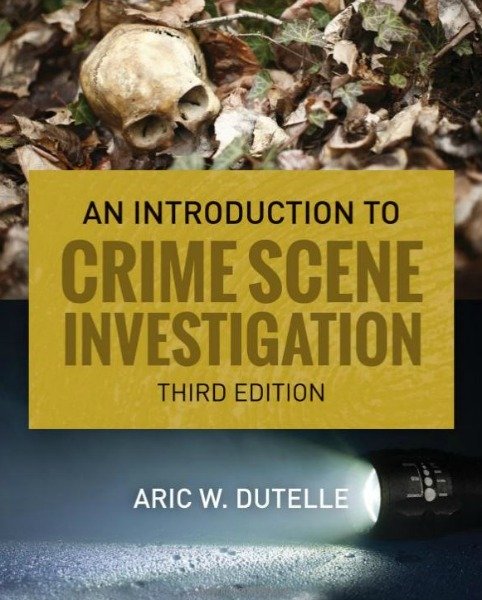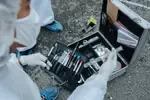Types of Crime Scene
The Outdoor Crime Scene
The outdoor crime scene is the most vulnerable to loss, contamination, and deleterious change of physical evidence in a relatively short period of time. Individuals with access to the scene can potentially alter, destroy or contaminate evidence.
The risk is greatest when crime scene investigators fail to secure the crime scene properly. Destruction or deterioration of evidence due to environmental conditions such as heat, cold, rain, snow and wind are problems associated with outdoor scenes. Evidence that cannot be protected under these conditions should be collected expeditiously without compromising its integrity. Investigators who encounter a combination of an indoor and outdoor scene should give priority to processing the outdoor component.
Nighttime outdoor crime scenes are particularly problematic. Regardless of the quality of the light source used to illuminate the scenes, the lack of sunlight can lead to investigators inadvertently missing or destroying evidence. Whenever possible, outdoor crime scenes should be held and secured until daylight for processing.
The Indoor Crime Scene
Evidence at an indoor scene is generally less susceptible to loss, contamination and deleterious change. Indoor crime scenes are usually easier to secure and protect, and securing a scene can be as simple as closing a door. The methods used by forensic laboratories have evolved so that very small amounts of biological material can produce a usable DNA profile. This, however, means that the potential for detecting DNA traces deposited by contamination at crime scenes becomes a factor.
|
Contamination of any crime scene can easily occur if proper precautions, such as limiting the number of people inside the scene, are not taken. For example, first responders, emergency medical personnel, patrol supervisors, crime scene investigators, and medical examiners are all potential sources of contamination and/or loss of evidence. |
|
The Conveyance Crime Scene
Conveyance is defined as "something that serves as a means of transportation." Types of crimes committed in conveyances include, but are not limited to:
- Vehicle Burglary.
- Grand Theft.
- Car Jacking.
- Sexual Battery.
- Homicide.
It is important that the crime scene investigator recognize that physical evidence recovered from these scenes may extend well beyond the conveyance itself. The flight path of the perpetrator may reveal evidence important to the investigation. For example, impression evidence, such as shoe or footprints in soil, may be found leading away from the scene, and property removed from the conveyance may be deposited or dropped as the perpetrator flees the scene.
Cigarette butts are sometimes found in and around the conveyance. The nature of the crime may give the investigator an idea of the type of evidence present. To protect the scene against inclement weather and other factors that may contribute to evidence loss and/or destruction, a conveyance such as a vehicle may be transported to the laboratory after proper documentation has been completed.
(Information provided by the Department of Justice)
Essential Reading
In a world heavily influenced by popular forensic television dramas, the real-life duties and complexities involved in crime-scene investigation are often misrepresented and misunderstood. An Introduction to Crime-Scene Investigation, Third Edition is a comprehensive and accurate overview of the practical application of forensic science in crime scene investigation. Focusing on the day-to-day aspects, this full-color text describes the methodologies and technologies employed by crime scene personnel, and pushes the reader to identify the interrelated components of the investigative process.
Recognizing the importance of those who have contributed to and advanced the field of forensic science, the reader is introduced to CSI through a historical perspective. The updated Third Edition covers components not typically found in many crime scene texts, including ethical considerations and public misconceptions of the investigative process—the so-called “CSI Effect.” Extensive discussion of physical evidence examination and analysis is provided, including the forensic potential of physical evidence, crime scene procedures, and what evidence should be documented, collected, and preserved. Real-life examples and over 250 detailed, full-color photos and figures enhance comprehension and demonstrate specific strategies for technique application
While the vast majority of the text is written with an American audience in mind, the author has chosen to call upon his significant international experience and include cases, information, and photographs/figures which are external to the United States.
An Introduction to Crime-Scene Investigation, Third Edition is an invaluable reference and essential educational resource.
See following link for full details.
Introduction to Crime Scene Investigation
Recent Articles
-
All About Forensic Science
Nov 12, 24 03:05 AM
A forensic science website designed to help anybody looking for detailed information and resources. -
The Role of Forensic Evidence in Criminal Defense Cases
Sep 05, 24 03:38 AM
Article exploring five key roles that forensic evidence plays in criminal defense cases -
The Evolving Role of Medical Science in Forensic Investigations
Aug 06, 24 03:35 AM
Insightful article exploring the critical role of medical science in forensic investigations.
Go To The Main Crime Scene Investigation Page



New! Comments
Have your say about what you just read! Leave me a comment in the box below.